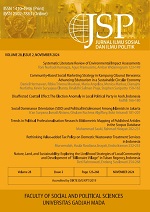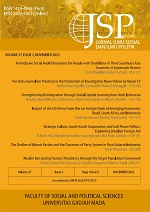Gender Discourses in Positioning Indonesian Female Migrant Workers
Wening Udasmoro(1*), Setiadi Setiadi(2)
(1) Department of Language and Literature, Universitas Gadjah Mada, Indonesia
(2) Department of Anthropology, Universitas Gadjah Mada, Indonesia
(*) Corresponding Author
Abstract
Indonesian female migrant workers are a group that has over time experienced physical, psychological, and verbal violence in their jobs in foreign countries. The story presented of the struggles of this subordinated group of women remains one-sided and incomplete. The untold part of the story are the experiences they have encountered domestically from within their own country, Indonesia. This article argues that the subordinated position of Indonesian female migrant workers is initially created and strongly reinforced through the discrimination they face within specific social settings in the Indonesian context. One such social setting is at Indonesian international airports. Indonesian international airports are where the female migrant workers are positioned as “others”; rules put in place and their enforcement by airport officials and other passengers show the exclusion of female migrant workers from Indonesian society. Such positioning is an act of discrimination, exploitation, and exercise of power. This study examines what discourses are used in positioning these Indonesian female migrant workers in Soekarno Hatta International Airport, Jakarta. The authors argue, using research data and gender theories, that the positioning of Indonesian female migrant workers is a discursive act. It is committed by various individuals, particularly those (in the power system) that have the position of “we” and “us”, to preserve the social classes, which have become normalized throughout Indonesian history. The research found that the discrimination against female migrant workers is strongly connected to their social class. Although they have financial capital, their position is considered lower than other people in the airport, which creates multiple forms of discrimination, from material to symbolic discrimination and stereotypes.
Keywords
Full Text:
PDFReferences
Abror, M. (2020). Wacana TKI dalam Novel Jatisaba Karya Ramayda Akmal. Poetika, 8(1), 64–78. https://doi.org/10.22146/poetika.v8i1.56541
Al-Fayyadl, M. (2015). Kritik Sastra Prancis. Poetika, 3(2), 143–153. https ://doi.org/10.22146/poetika.v3i2.10439
Allen, A., & Goddard, R. (2014). The domestication of Foucault: Government, Critique, War. History of the Human Sciences, 27(5), 26–63. https://doi.org/10.1177/0952695114538990
Amr. (2016). Jumlah TKI Asal Jateng Capai 9633 Orang [Mass Media]. Okezone. https://news.okezone.com/ read/2016/07/25/512/1446107/jumlah-tki- asal-jateng-capai-9-366-orang
Anggaunitairanantika, A., & Hamidi, M. (2020). Emotional Entanglement and Community Empowerment of Transnational Migrants’ Families: A Cross-Sectional Study in Malaysia and Indonesia. Global Social Welfare, 7(4), 1–10. https://doi.org/10.1007/ s40609-020-00191-3
Antara News. (2007). “Kasus Ceriyati Buktikan Indonesia Gagal Lindungi TKI” [Mass Media]. Antara News. https://www. antaranews.com/berita/66920/kasus- ceriyati-buktikan-indonesia-gagal
Apriliyanti, I. T. (2018). Aging Labor and Japanese Industry Performance: Lessons for Indonesia Policies. Jurnal Ilmu Sosial Dan Ilmu Politik, 22(1), 34–48.
BNP2TKI. (2011). “Sejarah Penempatan TKI Hingga BNP2TKI” [Gov ernment]. BNP2TKI. http://www.bnp2tki.go.id/ frame/9003/Sejarah-Penempatan-TKI- Hingga-BNP2TKI
Bourdieu, P. (1987). The Logic of Practice. Gallimard.
Butler, J. (1988). Performative Acts and Gender Constitution: An Essay in Phenomenology and FeministTheory. Theatre Journal, 40(4), 519–531.
Carey, G.,Dickinson, H., & Cox, E.M. (2018). Feminism, Gender, and Power Relations in Policy – Starting a New Conversation. Australian Journal of Public Administration, 77(4), 519–524. https://doi. org/10.1111/1467-8500.12324
Chan, C. (2014). Gendered Morality and Development Narratives: The Case of Female Labor Migration from Indonesia. Sustainability, 6, 6949–6972.
Collins, P. H. (1998). It’s All in the Family: Intersections of Gender, Race and Nation. Hypatia, 3(3), 62–82.
Crenshaw, K. W . (2013). From Private Violence to Mass Incarceration: Thinking Intersectionally About Women, Race, and Social Control. Journal of Scholarly Perspective, 9(1), 21–50.
Eleanor, M., Carson, L., & Yates, S. (2018). What can policymakers learn from feminist strategies to combine contextualised evidence with advocacy? Humanities and Social Sciences Communication, 4(104), 1–9. https://doi.org/10.1057/s41599-018-0160-2
Elias, J. (2013). Foreign Policy and the Domestic Worker: The Malaysia-Indonesia Domestic Worker Dispute. International Feminist Journal of Politics, 15(3), 391–410. https://doi.org/10.1080/14616742.2012.755835
Fiske, S. T., Cuddy, A., J. C., & Glick, P. (2011). Universal Dimensions of Social Cognition: Warmth and Competence. Trends in Cognitive Sciences, 11(2), 77–83.
Ford, M. (2006). Migrant Worker Organizing in Indonesia. Asia and Pacific Migration Journal, 15(3), 313–334. https: //doi.org/10.1177/011719680601500302
Foucault, M. (1980). Power/Knowledge: Selected interviews and other writings 1972-1977 (C. Gordon, Ed.). Harvester Press.
Giddens, A. (1984). The Constitution of Society: Outline of the Theory of Structuration. University of California Press.
Grabe, S. (2020). Research Methods in the Study of Intersectionality in Psychology: Examples Informed by a Decade of Collaborative Work With Majority World Women’s Grassroots Activism. Psychology. https://doi.org/doi.org/10.3389/ fpsyg.2020.494309
Hopkins, P. (2019). Social geography I: Intersectionality. Progress in Human Geography, 43(5), 937–947. https://doi.org/10.1177/0309132517743677
Hvenegard-Lassen, K., Staunaes, D., & Lund, R. (2020). Intersectionality, Yes, but How? Approaches and Conceptualizations in Nordic Feminist Research and Activism. NORA - Nordic Journal of Feminist and Gender Research, 28(3), 173–182.
Keban, Y. (2000). International Migration, the Strategy for National Development and Globalisation in Sukamdi. In A. Haris & P. Brownlee (Eds.), Labour Migration in Indonesia: Policies and Politics. Population Study Center, Universitas Gadjah Mada.
Killias, O. (2010). ‘Illeg al’ Mig rat ion as Resistance: Legality, Morality and Coercion in Indonesian Domestic Worker Migration to Malaysia. Asian Journal of Social Science, 38, 897–914. https://doi. org/10.1163/156853110X530796
Kompas. (2009, June 13). “TKW Ditahan Petugas, Kepala BNP2TKI Jumhur Hidayat: Itu Demi Melindungi Mereka”. Kompas.
Kristina, A. (2020). Key Policy Challanges: Social Security for Migrant Workers. International of Religious and Cultural Studies, 2(1), 7–19. https://doi.org/10.34199/ijeacs.2020.04.02
Kurniawan, M. L. D., Prasetyo, H., Wicaksono, A., & Akmal, U. F. (2019). Degradasi Puitika dalam Kontestasi Literasi Cerita KKN di Desa Penari. Poetika, 7(2), 216–231. https://doi.org/10.22146/poetika. v7i2.51571
Kusuma, A. J., York, M. R., & Wibowo, R. H. (2015). Violence Againts Indonesian Migrant Workers-A Causal Analysis. Jurnal Hubungan Internasional, 4(1), 47–57.
Lamsal, M. (2015). The Structuration Approach of Anthony Giddens. Himalayan Journalof Sociology and Anthropology, V, 111–122.
Liao, T. F., & Gan, R. Y. (2020). Filipino and Indonesian Migrant Domestic Workers in Hongkong: Their Life Courses in Migration. American Behavioral Scientist, 64(6), 740–764. https://doi. org/10.1177/00002764220910229
Loveband, A. (2007). Positioning the Product: Indonesian Migrant Workers in Taiwan. Journal of Contemporary Asia, 34(3), 336–348.
Ma, L. (2012). “Soekarno-Hatta Seperti Ibu Tiri bagi TKI” [Mass Media]. Kompasiana. http://birokrasi.kompasiana.com
Mafruhah, I., Istiqomah, N., Mulyani, N. S.,& Rahardjo, M. (2016). The Placement Model for Indonesian Migrant Workers to Improve their Economic Welfare. Journal of Business and Economic Review, 1(1), 42–50.
McGinn, K., & Oh, E. (2017). Gender, Social Class, and Women’s Employment. Current Option in Psychology, 18, 84–88. https://doi. org/10.1016/j.copsyc.2017.07.012
Mohanty, C. T. (1988). Under Western Eyes: Feminist Scholarship and Colonial Discourses. Feminist Review, 30, 61–88. https://doi.org/10.2307/1395054
Ningtyas, E. (2015). Pierre Bourdieu, Language and Symbolic Power. Poetika, 3(2), 154–155. https://doi.org/10.22146/poetika. v3i2.10437
Platt, M. (2018). Migration, Moralities and Moratoriums: Female Labour Migrants and the Tensions of Protectionism in Indonesia. Asian Studies Review, 42(1), 89–106. https://doi.org/10.1080/10357823.2017.1408571
Pratikno, R., Yazid, S., & Dewi, E. (2020). Enhancing the Role of Remittances through Social Capital: Evidence from Indonesian Household Data. Asian and Pacific Migration Journal, 29(1), 30–54. https://doi.org/10.1177/0117196820920401
Radar Lombok. (2016). Kasus Kekerasan Terhadap TKI Masih Tinggi. Radar Lombok. http://www.radarlombok.co.id/ kasus-kekerasan-terhadap-tki-masih- tinggi.html
Rice, C., Harrison, E., & Friedman, M. (2019). Doing Justice to Intersectionality in Research. Cultural Studies <--> Critical Methodologies, 19(6), 409–420. https://doi. org/doi.org/10.1177/1532708619829779
Rossi, A. (2017). Foucault, Critique, Subjectivity. Journal of Cultural Research, 21(4), 337–350. https://doi.org/10.1080/14797585.2017.1370486
Scott, J. W. (1988). Deconstructing Equality- Versus-Difference: Or, the Uses of Poststructuralist Theory for Feminism. Geopolitics Journal, 14(1), 33–51.
Setiadi. (2001). Masalah Reintegrasi Sosial dan Ekonomi Migran Kembali. Populasi, 12(1), 21–35.
Silvey, R. (2006). Consuming the Transnational Family: Indonesian Migrant Domestic Workers to Saudi Arabia. Global Network A Journal of Transnational Affairs, 6(1, January), 23–40.
Solidaritas Perempuan. (2014). Situasi Kekerasan dan Pelanggaran Hak Buruh Migran Perempuan dan keluarganya di Negara ASEAN. Solidaritas Perempuan.
Subiyantoro. (2014). Survival Strategies of the Javanese Language in New Caledonia. Humaniora, 26(1), 43–55.
Sururama, R., & Nanuru, T. (2019). The Role of the Ambon City’s Population and Civil Registration Office in Controlling Incoming Migration. Jurnal Ilmu Sosial Dan Ilmu Politik, 23(2), 163–177. https:// doi.org/10.22146/jsp.41525
Sutopo, O. R., & Putri, R. D. (2019). Mobilitas, Negosiasi dan Transisi Perempuan Muda di Jawa Tengah. Jurnal Studi Pemuda, 8 (1), 1–14. https://doi.org/10.22146/studipemudaugm.45962
Udasmoro, W. (2017). The Language Construction of Muslims in French Contemporary Discourses. Indonesian Journal of Islam and Muslim Societies, 7(1), 77–99. https://doi.org/10.18326/ijims.7il.77.99
Udasmoro, W., & Anwar, S. (2019). Contesting the Social Spaces: Gender Relations of Literary Communities in Yogyakarta and Surakarta. Indonesian Journal of Geography,51(3), 346–356.
Wahyuni, N. D. (2013). “4 Juta TKI Sumbang Devisa Rp. 100 Triliun ke Negara” [Mass Media]. Liputan 6. www.liputan6.com/bisnis/read/756717/4-juta-tki-sumbang-devisa-rp-100-triliun-ke-negara.
Wibowo, O. T., Udasmoro, W., & Noviani, R. (2020). Understanding New Consumption Sites of Internet Cafe in Yogyakarta, Indonesia. Jurnal Ilmu Sosial Dan Ilmu Politik, 23(3), 237–249.
Article Metrics
Refbacks
- There are currently no refbacks.
Copyright (c) 2021 Jurnal Ilmu Sosial dan Ilmu Politik

This work is licensed under a Creative Commons Attribution-NonCommercial-NoDerivatives 4.0 International License.























